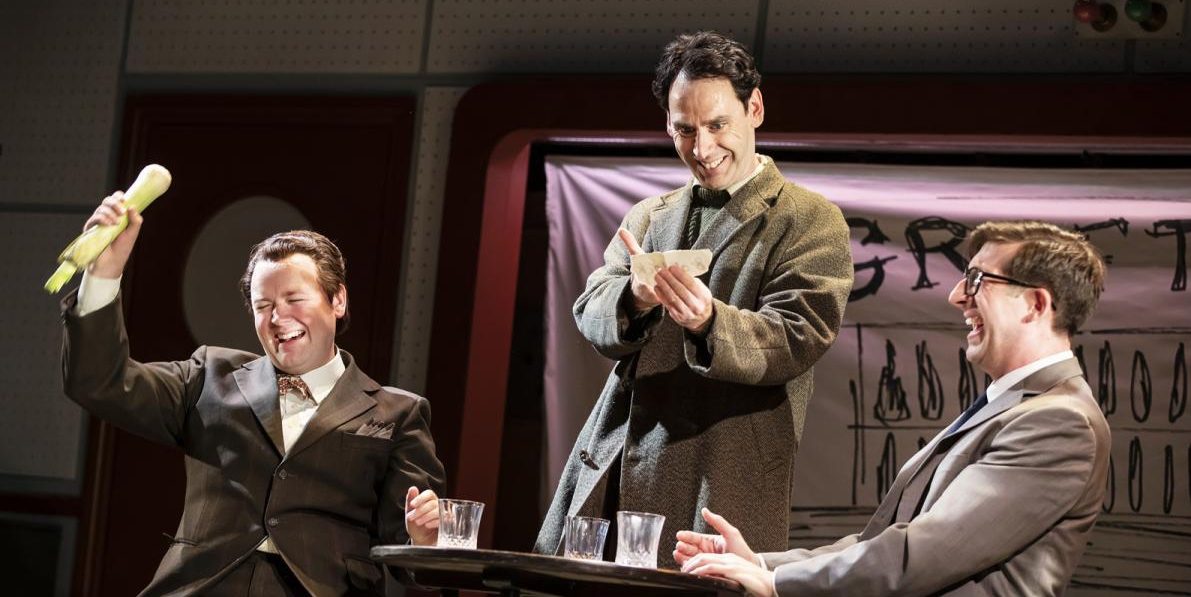Spike is an extremely entertaining biographical dramatic comedy about the life of Spike Milligan during his “Goons” period at the BBC. It includes as characters, therefore, Harry Secombe, Peter Sellers, Milligan’s first wife, June, and other historic characters as background support. It is very worth seeing.
Following the BBC Reithian practice, I felt by the end that the play had given me interesting information, educated me about an historically influential development of post-World War II comedy in Britain, and entertained me thoroughly. The writers Ian Hislop and Nick Newman know the history of the Goons fully and manage to convey their story with the tropes and jokes of the Goon Show itself.
In its staging by Paul Hart and in its design by Katie Lias, this show also portrays the working practices of radio shows in the 1950s, including hilarious material about sound effects. The presentation of Milligan’s innovative and sometimes manically vibrant yet gloomy mentality and how his scripts spooked some of the managers at the BBC, the play comments on the self-censoring, politically fearful, and sometimes cowardly attitudes at the BBC both then and now.
Some characters are missing: one of the founding members of the Goons, Michael Bentine, for example. But everyone who was involved with the shows at the beginning gets a name check and you can, from this play alone, piece together quite a lot of the history not just of the show and its cast but something of the revolutionary mentality of the comic fraternity of that era. The developments out of the Goon Show led to Monty Python, Fawlty Towers, and of course, Spitting Image, written by Ian Hislop and Nick Newman. These two playwrights are past masters of contemporary satire using knowledge of the past, as in their plays Wipers Times and Trial by Laughter to comment on our lives today.
Paul Hart has found just the right tone of voice in his staging. He deals powerfully and sensitively with Milligan’s WWII experiences, with Milligan’s shock and breakdowns, and with his resulting difficulties with relationships as well as his own problematic creativity. The script also deals forcefully with the rivalries and jealousies of some of the characters filling in details. Simple theatrical gestures fire the imagination of the audience.
There’s a lot of laughter, but there’s also the portrayal of the pain and suffering behind the clown’s job and the fright that good comedy can give to more conventional thinkers. Hart conjures the influence of the Goon show itself and also relates to the fashion for Theatre of the Absurd of that period. By looking closely at history Hislop and Newman are provoking us to think about its echoes today.
Robert Wilfort makes a believable and attractive Spike Milligan both emotionally and physically, embodying both Spike’s mad genius and his mental health problems; Jeremy Lloyd almost sounds like Harry Secombe when he sings and conveys the sense of his being the solid, reliable one, the anchor for the group; and Patrick Warner makes a convincing and at times louche Peter Sellers. The whole cast deserves praise, and there is a delightful satiric playfulness that weaves in and out of the show, including the lessons by Margaret Cabourn-Smith on how to create sound effects and the three critics who appear to tell you what they are thinking about Spike Milligan and the Goon Show.
This play is excellently executed and can be seen simply for the story it tells and the fine moments of comedy, but it’s also an important commentary on an historically and culturally significant moment in the British entertainment industry and the early developments of a style that’s still influential today.

